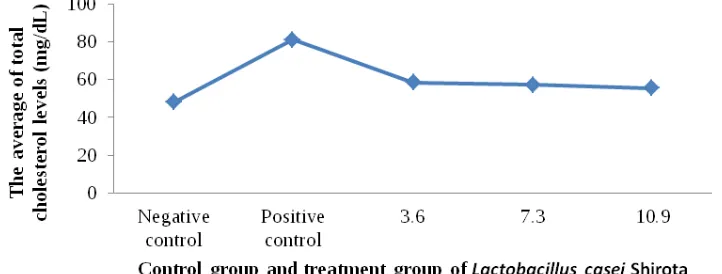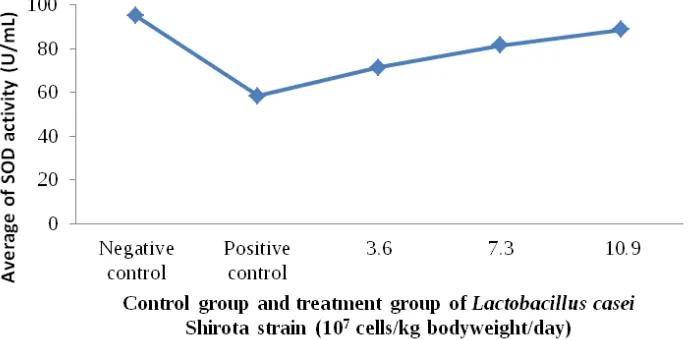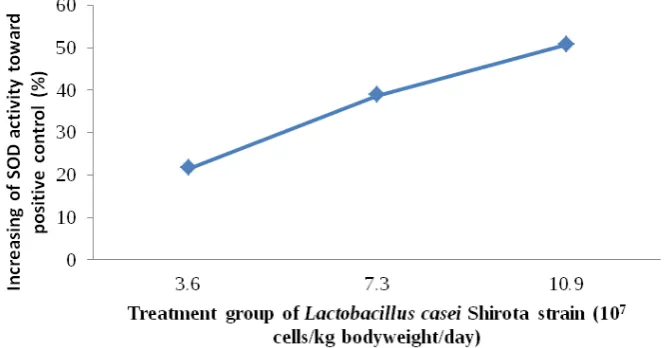Potential of Lactobacillus casei Shirota Strain Probiotic Toward Total Cholesterol Levels and Sod Activity in Rat with High Cholesterol Diet
Kiswanti Surya Utami1*, Chanif Mahdi1, Aulanni’am Aulanni’am1,2
1
Chemistry Department, Faculty of Mathematics and Natural Sciences, Brawijaya University, Malang, Indonesia
2
Faculty of Veterinary, Brawijaya University, Malang, Indonesia
*email: onetykeyko@gmail.com
Received July 25, 2017; Accepted November 03, 2017; Available online November 30, 2017
ABSTRACT
Probiotic of Lactobacillus casei Shirota strain is lactic acid bacteria that have benefits to enhance immunity system, as an antioxidant and has the ability to decrease the cholesterol level. The aim of this study was to determine the potential of Lactobacillus casei Shirota strain probiotic toward total cholesterol decreasing and
SOD activity increasing in rats’ aorta with a high-cholesterol diet. This study used 25 male rats of Rattus novergicus Wistar strain that will be divided into 5 groups. The 1st group as the negative control, and the 2nd group as positive control. The positive control group was induced by high-cholesterol diet contained quail egg yolk, pure cholesterol, cholic acid and waste oil that were given for 3 weeks. The 3rd, 4th and 5th group were treated by probiotic Lactobacillus casei Shirota strain with variation dose of 3.6 x 107, 7.3 x 107 and 10.9 x 107 cells/kg bodyweight/day. The results showed that probiotic of Lactobacillus casei Shirota strain therapy dose of 10.9 x 107cells/kg bodyweight/day can decrease the total blood cholesterol of rats’ serum that were given with high-cholesterol diet of about 32.0%. In addition, the probiotic of Lactobacillus casei
Shirota strain therapy also increase the activity of SOD about 50.70%.
Keywords: Lactobacillus casei Shirota strain, total cholesterol, superoxide dismutase
INTRODUCTION
Cardiovascular disease is caused by a disturbance in the heart and blood vessel function that are dangerous to health, the examples of cardiovascular diseases are coronary heart disease and stroke (Rastini, 2010). The cause of these disease is atherosclerosis. The main factors causing atherosclerosis is hypercholesterolemia or high cholesterol levels.
Cholesterol levels in the body can be determined by examining the total cholesterol level in the blood. The total cholesterol levels include of LDL, HDL and triglycerides. Normal total cholesterol levels in humans is <200 mg/dL. High levels of total cholesterol in the blood can be caused by high cholesterol diet. High cholesterol diet that performed continuously will cause an accumulation of LDL cholesterol in the blood vessels and oxidation of LDL cholesterol (Towil & Pramono, 2014). In addition, it will produce of free radicals or ROS (Reactive Oxygen Species) in the body.
ROS can be assailed by antioxidant of SOD (Superoxide Dismutase). The activity of SOD can be inhibite by ROS. The high of ROS in the body due to the induction of high-cholesterol diet can of cause a decrease in SOD
antioxidant activity (Bayatmakoo, Rashtci- zadeh, Yaghmaei, Farhoudi, & Karimi, 2017). SOD activity test is used to determine the resistance of cells against ROS.
Probiotic of Lactobacillus casei Shirota strain a lactic acid bacteria that can improve the health of digestive system. Moreover, these bacteria also have the ability to boost the immune system as well as antioxidant of cholesterol reducer. Probiotic of Lactobacillus casei Shirota strain commonly used in fermented beverages made from milk. Sujono, Bekti, Hikmawan & Yuananda (2016) goat milk yogurt that used Lactobacillus bulgaricus bacteria can be decresing the levels of total cholesterol by 52,17 mg/dL. Yuniastuti (2004) Fermented milk containing Lactobacillus casei Shirota strain can reduce the total cholesterol level. The ability of each probiotic to decrease the cholesterol may varies, depending on the type of probiotic bacteria used.
The aim of this study is to determine the potential of Lactobacillus casei Shirota strain probiotic with therapeutic dose of 3.6 x 107, 7.3 x 107 and 10.9 x 107 cells/kg bodyweight/day of male white rats (Rattus norvegicus) that induced by high-cholesterol
blood serum and SOD activity increasing in
rats’ aorta with a high-cholesterol diet. EXPERIMENTAL SECTION Material and Instrumentation
Chemicals used in this study is the probiotic of Lactobacillus casei Shirota strain that commercial, cholic acid (Kasei Tokyo), pure cholesterol (SIGMA), oil, egg yolk of quail, SOD kit (Biovision), BioSiystem S.A Costa Brava 30 kit, phosphate buffer saline (PBS) solution, tris HCl, PBS-tween, 0.9% sodium chloride, ethanol and distilled water.
The tools used in this study were centrifuges, analytical balance (Mattler Toledo), incubators, sepectrophotometer UV-Vis (Thermoscintific Genesys 20), bath water, gavage needle, microhematocrit or capillary tubes, Eppendorf tubes, microtube, surgical equipment, vacutainer, mortar, freezer, refrigerator, 96 well microplate, 3 mL syringe (Terumo), cuvette, mikropipet 100 µL and 1000 µL (Nichipet EX), microplate reader and Easy Touch GCU to check the blood cholesterol level experimental animals.
Procedure
Sample Preparation
Probiotic of Lactobacillus casei Shirota strain sample stored in the refrigerator (storage conditions temperature 0 – 10 °C). Probiotic bacteria used were Lactobacillus casei Shirota strain. The number of probiotic bacteria is groups: negative control (healthy), positive control (sick) that were given high-cholesterol diet for 3 weeks, and the three treatment groups were given high-cholesterol diet and treated with the probiotic of Lactobacillus casei Shirota strain orally with 3 dose (3.6 x 107, 7.3 x 107 and 10.9 x 107 cells/kg bodyweight/day) variations therapy. Probiotic of Lactobacillus casei Shirota strain therapy carried out for 2 weeks.
Measurement total cholesterol levels of blood serum
Total cholesterol levels were determined using BioSiystem S.A Costa Brava 30 kit, with CHOD-PAP method. Each rats’ blood was spectrophotometer at a wavelength of 500 nm. Measurement of superoxide dismutase (SOD) activity in aortic tissue
Measurement were started with SOD protein isolation from aortic tissue. Then, SOD activity is determined using SOD Biovision kit. Each sample of solutions were added about 20 µL and 2nd blank, and 20 µL of H2O were added in 1st blank and 3rd blank. Then they were added by 200 µL of WST (Water Soluble Tetrazolium) working solution in each sample. After that, dilution buffer was added about 20 µL in each 2nd blank and 3rd blank. In the other hand, in each sample and 1st blank were added by 20 µL of enzyme working solution and all of the mixture were being homogenate. Each mixture was incubated at 37°C for 20 minutes. Samples will be measured using a microplate reader with a wavelength of 450 nm.
RESULTS AND DISCUSSION
Total LAB And Total Cholesterol Levels of Blood Serum
The quantity of bacteria in probiotic Lactobacillus strain Shirota strain samples determined using Total LAB method which is 7.3 x 107 CFU/mL. These results are in accordance with the standards of SNI (2009) that the amount of LAB in fermented milk is at least equal to 107.
hypokolesterolemia effect (Ooi, Gaik, & Liong, 2010).
The results showed that probiotic of Lactobacillus casei Shirota strain therapy can reduce the total cholesterol level. The results of statistical analysis were deteremined using One Way ANOVA, and exhibited that probiotic therapy with Lactobacillus casei Shirota strain with variation dose of 3.6 x 107, 7.3 x 107 and 10.9 x 107 cells/kg bodyweight/day can decrease the total cholesterol levels by based on its extremely significant differences between each treatments (p<0.01). The results of the total cholesterol level can be seen in Figure 1.
Positive control group had a higher total cholesterol levels than the other groups of 81,2 mg/dL and an increasing of 69.8% toward a negative control. Total cholesterol levels in positive control group showed that rats had hypercholesterolemia, because of the total cholesterol levels above the normal range in
rats’. Harini & Astirin (2009) the normal total cholesterol levels in Rattus norvegicus Wistar strain rats is 10 – 54 mg/dL. This result indicates that the induction of high-cholesterol diet with the feed that contain of of pure cholesterol, cholic acid, quail egg yolk and oil (jelanta) can increase total cholesterol levels of rats.
Increased levels of total cholesterol is influenced by the content of saturated fatty acids and cholesterol that very high in a quail egg yolk and used oil and it completed with the addition of pure cholesterol. The content of cholesterol in eggs quail is 3640 mg/100g (Dewi, 2009). The used oil (jelantah) have highest total cholesterol levels among coconut oil, curah oil (oil without label) and lard oil, which is 86.20 mg/dL (Bogoriani & Ketut, 2015). Feeding 1% cholesterol for 2 months can increase blood serum cholesterol level of hypercholesterolemia group of rats by 90% (Wresdiyati, Astawan & hastanti, 2006).
Figure 1. The result of total cholesterol levels after treatmen by probiotic of Lactobacillus casei Shirota strain
Therapy group that were treated with probiotic of Lactobacillus casei Shirota strain 10.9 x 107 cells/kg bodyweight/day had the best total cholesterol levels wich is 55,2 mg/dL with a decreasing of 32.0%. Dereasing of total cholesterol levels can be seen in Figure 2. This results showed that the probiotic of Lactobacillus casei Shirota strain can decrease the total cholesterol levels. This is in accordance with Yuniastuti (2004) that the provision of fermented milk of Lactobacillus casei Shirota strain capable to lowering total cholesterol, triglyceride levels and LDL cholesterol levels significantly. Kumar, Grover, & Kumar (2010) showed that, supplementation of the diet with L. plantarum Lp91 can significant reduction in plasma total cholesterol 23.26%.
Probiotic bacteria can reduce the total cholesterol levels of blood serum in a variety of ways, include increasing the excretion of bile acids, with deconjugating the bile acids by BSH (Bile Salt Hydrolase) enzyme from probiotic mechanism (Yuliana, 2012). In the other hand, cholesterol assimilation is done by the probiotic directly. In the mechanism of cholesterol assimilation, lactic acid bacteria will take cholesterol from the intestine and incorporate with cellular membrane of bacteria, so the bacteria will more resistant to lysis (Yuniastuti, 2004). Cholesterol was bound to bacterial cells and this was a result of the chemical and structural properties of their cell wall peptidoglycans (Kimoto-Nira et al., 2007). The decreasing of cholesterol absorbed in the intestine bringin on the decreasing of blood cholesterol levels.
Lactobacillus acidophilus were able to assimilate cholesterol by 48,45 µg/mL (Tamaro-duschesneau et al., 2014). In addition, another mechanism of cholesterol reduction by bacteria can be done by converting cholesterol into coprostanol. Lye, Rusul, & Liong (2010) the results showed that cholesterol levels were decreased in medium due to fermentation by probiotic bacteria followed by increased coprostanol. Some of these mechanisms may work together to lowering cholesterol levels. Superoxide dismutase (SOD) activity in aortic tissue
The statistical analysis results with One Way ANOVA showed that probiotic therapy with Lactobacillus casei Shirota strain with dose variation of 3.6 x 107, 7.3 x 107 and 10.9 x 107 cells/kg bodyweight/day can increase the activity of SOD by showed extremely significant differences among the treatments
(p<0.01). The results of SOD activity in rats’
aorta can be seen in Figure 3.
In Group positive control, the rats experienced a decreasing activity of SOD by 38.16% compared to the negative control group. The low activity of SOD in the positive control group is due to the high-cholesterol diet which has an effect on the increasing of free radicals in the body exceed the body's capacity to avoid them. The high production of ROS in the body can caused a decreasing of SOD. Dianita, Jantan, Jalil, & Amran (2016) suggested that the hypercholesterolemic status hastriggeredoxidativestressasindicatedbya
significantdecreaseofserumSOD.
Figure 4. Increasing of SOD activity after treatmen by probiotic of Lactobacillus casei Shirota strain
The highest increasing percentage of SOD activity is 50,70% in the treatment group with a dose of 10.9 x 107 cells/kg bodyweight/day. The result of decreasing activity of SOD can be seen in Figure 4. Increasing of SOD activity is due to the probiotic of Lactobacillus casei Shirota strain that containing bioactive peptides as an antioxidant. Sari, Kusrahayu, & Al-baarri (2014) One of the bioactive components that naturally present in milk is lactoferrin compound. The result of SDS-PAGE in skim milk showed the presence of lactoferin compounds that is in molecular weight range of 80 kDa.
The mechanism of lactoferrin as an antioxidant protein is iron binding. Iron ion in certain circumstances can participate in the form Fenton reaction, which can generate ROS (hydroxyl radical) that are very reactive (Moradian, 2014).
The highest value of SOD activity is negative control and the lowest is positive control. The three treatment groups were slightly increased. The treatment group in 10.9 x 107 cells/kg bodyweight/day of dose therapy showed that the SOD activity had the highest value than the other treatment groups. In addition, the probiotic of Lactobacillus casei Shirota strain therapy can increase the activity of SOD.
CONCLUSION
Probiotic of Lactobacillus casei Shirota strain therapy has an ability to decrease the blood cholesterol levels and increase the SOD activity in aorta of rats that fed with a high-cholesterol diet.
REFERENCES
Bayatmakoo, R., Rashtchizadeh, N., Yaghmaei, P., Farhoudi, M., & Karimi, P. (2017). Thymol decreases apoptosis and carotid inflammation induced by hypercholesterolemia through a discount in oxidative stress. Crescent Journal of Medical and Biological Science, 4(4), 186–193.
Bogoriani, N. W. & Ketut, R. (2015). Efek berbagai minyak pada metabolisme kolesterol terhadap tikus wistar. Jurnal Kimia, 9, 53-60.
Dewi, A. B. F. K. (2009). Menu sehat 30 hari untuk hiperkolesterol, hipertensi, dan penyakit jantung. Jakarta: PT. Agro Media Pustaka.
Dianita, R., Jantan, I., Jalil, J., & Amran, A. Z. (2016). Phytomedicine Effects of Labisia pumila var alata extracts on the lipid profile, serum antioxidant status and abdominal aorta of high-cholesterol diet rats. Phytomedicine, 23(8), 810– 817.
http://doi.org/10.1016/j.phymed.2016.04 .004
Harini, M., & Astirin, O. P. (2009). Blood cholesterol levels of hypercholes-terolemic rat (Rattus norvegicus) after VCO treatment. Nusantara Bioscience, 1(2), 53–58.
http://doi.org/10.13057/nusbiosci/n0102 01
Indonesia Nation Stadardization (SNI). (2009). Yogurt. Jakarta: National Standardiza-tion CorporaStandardiza-tion (BSN).
Kobayashi, M., Fujita, Y., Okamoto, T., Suzuki, I., Tsuji, N. M., Kurisaki, J. I., & Ohmomo, S. (2007). Lactococcus sp. as potential probiotic lactic acid bacteria. Japan Agricultural Research. Quarterly, 41, 181-189.
Kumar, R., Grover, S., & Kumar, V. (2010). Hypocholesterolaemic effect of dietary inclusion of two putative probiotic bile salt hydrolase producing Lactobacillus Plantarum strains in sprague-dawley rats. British Journal of Nutrition, 1-12. Lye, H. S., Rusul, G., & Liong, M.T. (2010).
Removal of cholesterol by Lactobacilli via incorporation of and conversion to coprostanol. Journal of Dairy Science, 93, 1383-1392.
Moradian, F. (2014). Lactoferrin, Isolation, Purification and Antimicrobial Effects. Journal of Medical and Bioenginering, 3(3), 203-206.
http://doi.org/10.12720/jomb.3.3.203-206
Ooi, G. L. & Liong, T. M. (2010). Cholesterol-lowering effects of probiotics and prebiotics: A review of in vivo and in vitro Findings. International Journal of Molecular Sciences, ISSN 1422-0067 Malaysia, 2499-2522.
Rastini, E. K., Widodo, M. A., & Rohman, M. S. (2010). Pengaruh pemberian ekstrak buah mengkudu (Morinda citrifolia L.) terhadap ekspresi NF-kβ dan ekspresi protein (TNF-α, ICAM-1) pada kultur sel endotel (HUVECs) dipapar OxLDL.
The Journal of Experimental Life Science, 1, (1). ADDIN Mendeley Bibliography CSL_BIBLIOGRAPHY Sari, C. S., Kusrahayu, K., & Al-baarri, A. N.
(2014). Imobilisasi Komponen Bioaktif Susu dengan Menggunakan Resin. Aplikasi Teknologi Pangan, 3(1), 26–31. Sujono., Bekti, Y., Hikmawan., & Yuananda. (2016). Effec of Goat Milk Yogurt towards Reducing Uric acid, Cholesterol, and Blood Glucose Level. International Jurnal of Applied Environmental Science, ISSN 0973-6077, 11 (5), 1189-1197.
Tomaro-duchesneau, C., Jones, M. L., Shah, D., Jain, P., Saha, S., & Prakash, S. (2014). Cholesterol Assimilation by
Lactobacillus Probiotic Bacteria : An In
Vitro Investigation. Biomed Research International, 2014, 9.
http://dx.doi.org/10.1155/2014/380316 Towil, A. S., & Pramono, A. (2014). Pengaruh
pemberian yoghurt sinbiotik tanpa lemak ditambah tepung gembili terhadap kadar kolesterol LDL tikus hiperkoles-terolemia. Jurnal Gizi Indonesia, 135– 140.
Yuliana, D. 2012. Kajian mekanisme hipokolesterolemik probiotik. Majalah farmasi dan farmakologi, 12 (2), 95-98. Yuniastuti, A. (2004). Pengaruh pemberian


